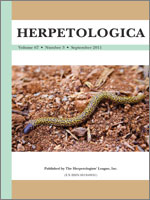Herbivory is the dominant feeding strategy in tortoises, and dietary shifts are common in response to changes in resource availability. We conducted the first large-scale study of the diets of wild Hermann's Tortoises (Testudo hermanni hermanni) and found that the study population in central Italy was strictly herbivorous. The tortoises ate primarily legume leaves and grasses in the spring, and switched to flowers and unripe fruit of Ruscus aculeatus as these became available in the autumn. There were no significant differences between the diets of males and females. Although tortoise diets included both rare and abundant plant species, they consumed abundant plant species in a higher proportion than those species occurred in the study area. However, some rare plants made up relatively large fractions of the diet, and one of the few nonnative plants (Conyza canadensis) at the study area was eaten frequently by tortoises in all seasons, despite its relative rarity. Ruscus aculeatus berries may be particularly valuable to tortoises that are about to enter hibernation; hence, T. hermanni habitat should be managed to maintain this important plant species.
How to translate text using browser tools
1 September 2011
Seasonal Changes in the Diet of Testudo hermanni hermanni in Central Italy
Silvia Del Vecchio,
Russell L. Burke,
Lorenzo Rugiero,
Massimo Capula,
Luca Luiselli
ACCESS THE FULL ARTICLE

Herpetologica
Vol. 67 • No. 3
September 2011
Vol. 67 • No. 3
September 2011




